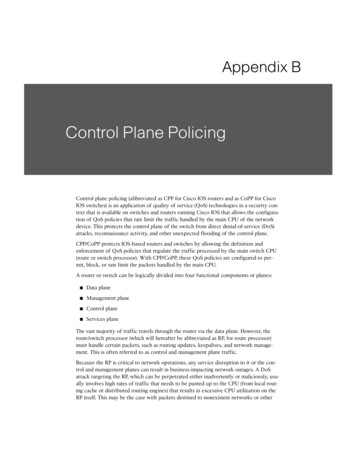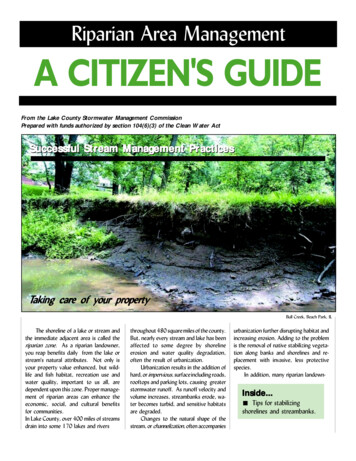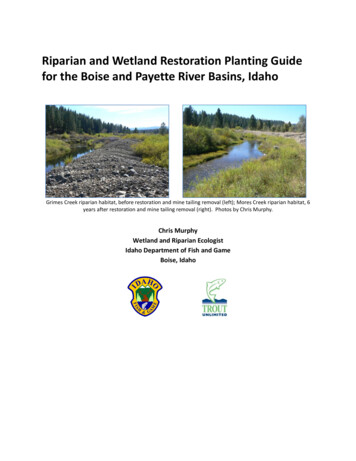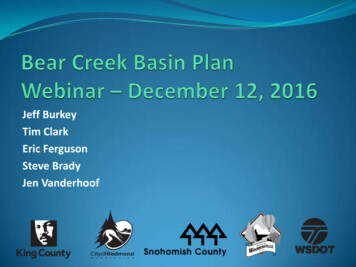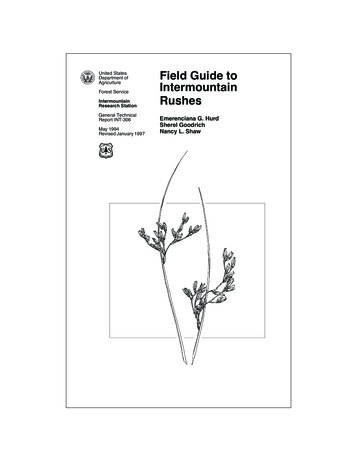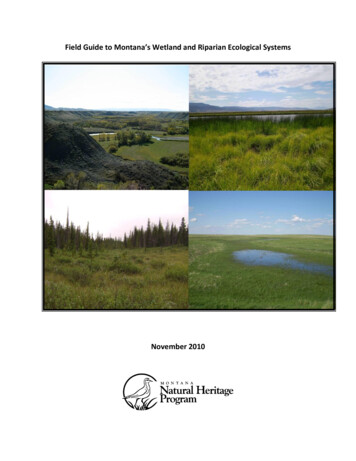
Transcription
United States Department of AgricultureThe NationalRiparian Core Protocol:A Riparian Vegetation Monitoring Protocolfor Wadeable Streams of theConterminous United StatesForest ServiceRocky MountainResearch StationGen. Tech. Rep.RMRS-GTR-367November 2017
Merritt, David M.; Manning, Mary E.; Hough-Snee, Nate, eds. 2017. The National RiparianCore Protocol: A riparian vegetation monitoring protocol for wadeable streams of theconterminous United States. Gen. Tech. Rep. RMRS-GTR-367. Fort Collins, CO: U.S.Department of Agriculture, Forest Service, Rocky Mountain Research Station. 37 p.AbstractRiparian areas are hotspots of biological diversity that may serve as high quality habitat for fish andwildlife. The National Riparian Core Protocol (NRCP) provides tools and methods to assist naturalresource professionals in sampling riparian vegetation and physical characteristics along wadeablestreams. Guidance is provided for collecting basic information on riparian vegetation compositionand physical structure in fluvial riparian ecosystems. The NRCP provides a foundation to assessthe characteristics and condition of channels and riparian vegetation at a single point in time or inresponse to changes in land- and water-use activities, including restoration, or natural processesthrough time.Keywords: floodplains, monitoring, protocol, riparian vegetation, valley bottom classification,vegetation assessment, wadeable streamsEditorsDavid M. Merritt, Ph.D. (dmmerritt@fs.fed.us), is the riparian ecologist at the USDA Forest ServiceNational Stream and Aquatic Ecology Center and affiliate faculty in the Department of Forest andRangeland Stewardship and the Graduate Degree Program in Ecology, Colorado State University,Fort Collins, Colorado.Mary E. Manning, M.S. (mmanning@fs.fed.us) is the regional vegetation ecologist for the USDAForest Service Northern Region, Missoula, Montana.Nate Hough-Snee, Ph.D., (nwhoughsnee@fs.fed.us) is a riparian ecologist contracted to the USDAForest Service National Stream and Aquatic Ecology Center through Meadow Run Environmental,Leavenworth, Washington.Photo credit: Mary E. Manning.All Rocky Mountain Research Station publications are published by U.S. Forest Service employees and are in thepublic domain and available at no cost. Even though U.S. Forest Service publications are not copyrighted, theyare formatted according to U.S. Department of Agriculture standards and research findings and formatting cannotbe altered in reprints. Altering content or formatting, including the cover and title page, is strictly prohibited.
ContributorsIn addition to the editors, the National Riparian Team that initially developed and drafted theNational Riparian Protocol consisted of:Erick A. Carlson, Ph.D. Candidate, Colorado State University, Fort Collins, Colorado.Marc Coles-Ritchie, Ph.D., Ecologist, Grand Canyon Trust, Salt Lake City, Utah.Kathleen A. Dwire, Ph.D., Research Riparian Ecologist, USDA Forest Service, Rocky MountainResearch Station, Fort Collins, Colorado.Lina Polvi, Ph.D., Assistant Professor of Fluvial Geomorphology, Umea University, Umea, Sweden.Gregg M. Riegel, Area Ecologist, USDA Forest Service, Deschutes National Forest, Bend, Oregon.Dave A. Weixelman, Regional Rangeland Ecologist, USDA Forest Service, Pacific SouthwestRegion, Vallejo, California.With assistance from:Janet Grove, Retired, USDA Forest Service, Tonto National Forest, Phoenix, Arizona.F. Jack Triepke, Regional Ecologist, USDA Forest Service, Southwestern Region, Albuquerque,New Mexico.AcknowledgmentsWe thank these National Forests for reviewing, testing, and providing feedback on the NationalRiparian Protocol: Hiawatha, Malheur, Umatilla, Wallowa-Whitman, San Juan, Green Mountain,White Mountain, Medicine Bow-Routt, Allegheny, and Daniel Boone. Jessie Salix (BeaverheadDeerlodge National Forest) and Brett Roper (National Stream and Aquatic Ecology Center)provided excellent reviews of the concepts and methods presented in the final protocol.Additionally, we thank the National Riparian Service Team for reviewing the protocol, and ColoradoState University for developing, testing, field validating, and providing classification map products ofthe Hydrogeomorphic Valley Classification. We thank Linda Spencer for helpful dialogue regardingriparian resources and monitoring. We thank Constance Lemos, Patricia Cohn, and Lane Eskew forproviding editorial assistance on behalf of the Rocky Mountain Research Station.The use of trade or firm names in the publication is for reader information and does not implyendorsement by the U.S. Department of Agriculture of any product or service.
At a GlanceWhy a National Riparian Protocol for the Forest Service?The purpose of the National Riparian Protocol is to provide guidance on sampling riparianvegetation and physical characteristics along wadeable stream channels and their associatedfloodplains and valley bottoms. Many riparian areas have been altered or degraded by historic andcurrent land use and alterations in the timing, magnitude, and duration of peak and minimum flows.These land- and water-use patterns shape channel and streamside landforms and the compositionand structure of the associated vegetation. There is a need for a basic, flexible protocol thatprovides a foundation to assess the composition and physical structure of riparian vegetation sothat riparian condition can be explicitly linked to land- and water-use activities. The same protocolcan be used to monitor riparian ecosystem change following restoration activities or naturaldisturbances.What is the National Riparian Core Protocol (NRCP)?This NRCP is a basic protocol designed for sampling ecologically important characteristics ofriparian areas at the reach scale, including: (1) species composition, (2) vertical structure ofvegetation, (3) size-class structure of trees, and (4) physical channel characteristics. The NRCPis intended to guide land managers in gathering riparian data so that they may make comparisonsamong multiple reaches or track the trajectory of reaches’ vegetation composition and structureover time. This core protocol provides a flexible framework that can be used to collect basicinformation on riparian vegetation composition and structure for reach characterization, and/orused as the foundation of a long-term monitoring program that is implemented to answer specificmanagement questions. The NRCP complements existing agency protocols for monitoring riparianvegetation resources and may be paired with aquatic and fishery-related protocols when largerbiological inventories are required.Who was the protocol designed for?The protocol was designed for resource managers who are undertaking objective-based riparianmonitoring and for those tasked with monitoring riparian vegetation to track changes throughtime. This NRCP was designed for botanists, plant ecologists, rangeland scientists, foresters,hydrologists, and other resource specialists. With proper training, it can be carried out in the fieldby biological or hydrological science technicians. Because streams and their riparian areas arecomplex systems, teams of multiple resource specialists with plant or forest ecology, hydrology,and/or geomorphology backgrounds will be able to most effectively implement the protocol and pairthe resulting data with meaningful hydrologic and/or watershed disturbance data.Where can the protocol be applied?The methods outlined in the NRCP are intended for use on a variety of stream types and withina variety of valley settings. Flexibility is deliberately built into this protocol, and the managermust tailor the methods to specific sites, settings, and conditions to best meet project objectives.Monitoring plans tailored to meet clearly defined objectives under a well-defined scale, scope, andarea of interest are essential to collecting informative riparian vegetation data.What types of disturbances or land management issues can this protocol be used to monitor?The protocol can be used to effectively assess riparian vegetation responses to multipledisturbances. These include, but are not limited to: How riparian vegetation changes across hydrologic gradients and fluvial landforms along agiven stream reach;ii
How natural (insect, herbivory, disease), fluvial (stream-related), or human-caused disturbanceshapes vegetation composition over time; and The effectiveness of stream or riparian restoration in recovering desirable attributes of riparianvegetation, including composition, structure, habitat value, and individual tree fitness.Additional methods are available to augment this core protocol. Guidance for addingmeasurements to meet specific objectives, such as characterizing grazing impacts, quantifyinghabitat characteristics, and determining the effects of vegetation removal, etc., are referencedbelow and can be found in the more extensive USDA Forest Service Riparian Monitoring ProtocolTechnical Guide, Merritt, David M.; Manning, Mary E.; Hough-Snee, Nate. In preparation. Theriparian vegetation monitoring technical guide: Rationale, guidance, and methods for samplingwadeable streams. Gen. Tech. Rep. RMRS-GTR-XXX. Fort Collins, CO: U.S. Department ofAgriculture, Forest Service, Rocky Mountain Research Station. 187 p.What are the value-added applications of the protocol? Can the protocol be integrated with existinghydrologic, fisheries, aquatic, wildlife, and rangeland monitoring applications?Data collected under the NRCP may fit into existing monitoring efforts on many forests,including monitoring already being conducted for rare and endangered plants, fish or benthicmacroinvertebrate community composition and abundance, stream habitat (geomorphic) surveys,water quality, wildlife community composition and abundance, and grazing impacts. In many cases,vegetation data collected with this protocol can be used to inform studies or report the condition ofhabitat and stream-related natural resources. The data collected with the NRCP can be modifiedto effectively characterize riparian ecosystems for many National Forest planning purposes,including National Environmental Policy Act (NEPA), National Forest Management Act (NFMA), andEndangered Species Act (ESA) analyses.Are additional resources that augment the core protocol available for Forest Service staff?The USDA Forest Service Riparian Monitoring Protocol Technical Guide will be available in 2018.This guide provides background on fluvial geomorphic, hydrologic, and ecological principles andprocesses for scientists with a general background not focused on rivers. Both the Core Protocoland Technical Guide are to be accompanied by a training video in 2018.iii
ContentsAt a Glance. iiOverview.1Site Selection and Reach Determination.3Identifying Stream Segments and Reaches.4Sample Units and Sampling Intensity.5Riparian Area Determination.6Active Channel Determination.7Transect Layout for Channel and Vegetation Measurement.7Point Layout and Vegetation Sampling Along Transects.10Vegetation Sampling. 11Woody and Herbaceous Vegetation.12Tree Stem Density, Basal Area, and Condition.13Plant Specimen Collection.15Physical Feature Measurement.15Geomorphic Classification of Fluvial Surfaces.15Active Channel Width.17Channel Cross-Sections.17Reach Longitudinal Profile.18Data Entry, Quality Control and Assurance, and Analysis Techniques.18References.19Appendix 1—Overview of Valley Determination and ReachLocation Workflow to Guide Field Sampling.23Appendix 2—Field Sampling at a Glance.25Appendix 3—Gear List for Line-point Intercept Method.27Appendix 4—Random Numbers for Determining Initial Transect Location.28Appendix 5—Determination of Number of Points at a Site andAlong a Transect.29Appendix 6—Special Cases.30Appendix 7—Objective-Based Add-ons to the Core Riparian Protocol.31Appendix 8—Vegetation Data Field Forms.32Index of Key Terms.35iv
The National Riparian Core Protocol:A Riparian Vegetation MonitoringProtocol for Wadeable Streams ofthe Conterminous United StatesEdited by David M. Merritt, Mary E. Manning, and Nate Hough-SneeOverviewRiparian areas, the interface between aquatic and terrestrial environments, areoften physically heterogeneous and biologically diverse, and they may have high ratesof species turnover over time relative to surrounding uplands. Riparian ecosystemsprovide critical habitat for aquatic, semi-aquatic, and terrestrial plant and animal species, but they have also been historically degraded from land use, flow alteration, andinvasive species. Although there is an urgent need to understand their spatial extent,condition, structure, and function, the dynamic nature of stream channels makessampling, monitoring, and evaluating riparian vegetation challenging. This difficultyhas given way to the development of standardized riparian monitoring methods withinmany land management agencies.This document describes the USDA Forest Service’s National Riparian CoreProtocol (NRCP), which provides guidance on measuring riparian vegetation and channel characteristics along wadeable stream channels and their associated floodplains andvalley bottoms. This core protocol is designed to guide plant ecologists and botanists,rangeland scientists, foresters, hydrologists, and other resource specialists in gatheringdata to assess (1) riparian plant species composition across multiple canopy and groundcover strata and (2) channel conditions at the reach scale. When employed at a singlepoint in time, the data collected with this protocol can be used to compare plant speciescomposition and riparian conditions among multiple reaches. When conducted repeatedly at a single reach (or a set of reaches), riparian condition can be assessed throughtime to track trends in riparian plant species composition and structure.Numerous methods have been developed for measuring riparian condition for agiven stream type and set of objectives, such as looking at the effects of grazing or water withdrawal on riparian vegetation. Such methods are often adequate for achievingspecific goals along the stream channel types for which they were designed. However,there is no protocol that is optimal for every stream and every purpose. Monitoringprotocols, including the NRCP, should be tailored to meet clearly defined objectives—that is, to answer specific questions—across clearly defined spatial and temporal scales,within a specified geographic area of interest. This core protocol is designed to measurekey characteristics of riparian areas that include: (1) species composition, (2) vertical structure of vegetation, (3) size-class structure of trees, and (4) physical channelcharacteristics.USDA Forest Service RMRS-GTR-367. 2017.1
The methods outlined within the NRCP are intended for use on a variety of stream typesand valley settings across the conterminous United States. These methods include workflows for: using geospatial data to identify valley trend and valley types, stream segments, andindividual reaches for sampling, establishing vegetation transects and channel cross-sections, sampling vegetation strata and substrate characteristics using the line-point interceptmethod, sampling tree and shrub composition, size structure, and condition, and surveying channel cross-sections and reach longitudinal profiles.The core protocol has been designed to be flexible, and it is necessary for the investigator to tailor the methods to specific sites, landscape settings, environmental conditions, andproject objectives. The number of transects, spacing of transects and/or points per transect,and specific sampling techniques may need to be modified for specific projects.The approaches outlined in the NRCP, while flexible, are predicated upon several guiding assumptions: Monitoring design, data collection, analyses, and interpretation are conducted or supervised by a qualified plant ecologist, preferably one with experience working in riparianareas. Prior to any field data collection, sample reaches that address the monitoring questionhave been carefully selected using Geographic Information Systems (GIS) data, aerialphotographs, topographic maps, and/or field reconnaissance. Each sample reach is comprised of a distinct and continuous valley type, geomorphicsetting, and stream type. The sample reach is not located at a tributary junction. For longitudinal monitoring, reaches will be sampled repeatedly and consistentlythrough time. This means that reach endpoints (top-of-reach, bottom-of-reach) shouldbe permanently marked and easily relocated. As will be discussed below, repeatedrandom (probabilistic) sampling of a reach is advised if the channel is likely to changelocations over time through channel migration, avulsion, channel rerouting as a part ofrestoration, etc. Other factors influencing plant species composition such as livestock grazing, mechanical disturbance, wildfire, etc., are identified prior to monitoring and accounted for indata analysis and interpretation.The NRCP provides a simple, flexible framework for collecting riparian vegetationcomposition and structure for reach characterization, and/or as the foundation of a longterm monitoring program that is employed to answer specific questions. Accordingly, thisdocument is organized to guide land managers through the NRCP process, from identifying sample units and sampling intensity in the office, to data collection in the field, andfrom raw data to insightful analyses. Additional methods are available to augment this coreprotocol and guidance for adding measurements that meet specific objectives, includingcharacterizing grazing impacts, quantifying aquatic habitat characteristics, determining the2USDA Forest Service RMRS-GTR-367. 2017.
effects of vegetation removal, etc. These are provided in the larger USDA Forest ServiceRiparian Vegetation Monitoring Technical Guide (hereafter Riparian Technical Guide;Merritt et al. In preparation).Site Selection and Reach DeterminationFor a given application of the protocol, the valley extent and type, stream segment, andstream reaches that will be sampled should be identified in the office prior to sampling.The valley type through which a stream flows is determined by valley slope, width, form,and geology. Valley type constrains the range of stream channel forms that may occuralong a stream segment, which in turn governs stream physical characteristics and theriparian vegetation that may occur at a site. When selecting reaches for sampling, the firststratification that should occur among candidate reaches is the identification and organization of the stream segment or channel network by valley type.There are several valley bottom and valley type classifications and geospatial toolsavailable to land managers, including the Hydrogeomorphic Valley Classification(HGVC) framework of Carlson (2009), which identifies different valley types acrosswhich riparian samples can be stratified or paired and reference conditions established.The HGVC framework takes a process-based approach to identifying valley bottoms, isfreely available, and was created in collaboration with Forest Service scientists, makingit ideal for application on National Forest System lands. The HGVC identifies nine valleytypes for the western United States:(1) headwater,(2) high-energy coupled,(3) high-energy open,(4) gorge,(5) canyon,(6) moderate-energy confined,(7) moderate-energy unconfined,(8) glacial trough,(9) low-energy floodplain.Different valley types occur in different landscape settings and support streams withdifferent energy potential, physical character, and hydraulic behavior under differentflows. Due to inherent differences within and between streams, the sampling layout, number and length of transects, and other measurements will vary by valley type (Frissel et al.1986; Poole et al. 1997). Applying an initial classification of valley types within the studyarea is important so that replicate reaches along a segment are of similar valley form.When control or reference segments are compared to impacted segments, both segmentsshould occur within the same valley type.At this time, HGVC data are available through the U.S. Forest Service ArcGIS Onlineportal National Riparian Protocol group at: http://usfs.maps.arcgis.com. Documentationfor the HGVC is provided in Carlson (2009) and at the U.S. Forest Service ArcGISOnline portal.USDA Forest Service RMRS-GTR-367. 2017.3
In addition to the HGVC, additional valley classifications, such as the Rosgen ValleyClassification (Rosgen 1996), or mapping tools, such as the Landscape Scale ValleyConfinement Algorithm (Nagel et al. 2014) or the Valley Bottom Extraction Tool (Gilbertet al. 2016), may be used to place reaches in a watershed context (Frissell et al. 1986) andrefine the extent and type of valley that is mapped and to stratify reaches by their valleytype within a sampling design. Regardless of the valley classification used, the samplereaches selected for comparison should occur within the same distinct and representativevalley forms. If using the HGVC or other geomorphic classifications to classify valleytypes is not possible, then managers can measure valley width and slope from digitalelevation models such as the USGS National Elevation Dataset. Quadrangle maps maybe used to stratify reaches by valley width and channel slope and coarsely define valleytypes when GIS topography data are unavailable.After identifying reach types and extents, valley bottom polygons from the HGVCor other valley bottom delineations should be intersected with the stream segment andsample reaches. Using GIS, Google Earth, or equivalent software, managers should drawa centerline over the valley extent that parallels the valley direction and/or valley walls.This valley centerline outlines how valley direction changes from the top of a valley tothe bottom, and dictates how transects are placed perpendicular to the valley extent forstream sampling (Appendix 1).Identifying Stream Segments and ReachesA valley segment is the length of stream of interest. It is typically several-to-manystream reaches in length (Bisson et al. 2006; defined below). For most Forest Servicemonitoring applications, a relevant valley segment is likely to be the portion of streamlocated upstream or downstream from a point of impact such as a dam, diversion, or grazing allotment; a length of stream between tributary junctions where channels converge;or any portion of a stream consisting of multiple sample reaches at which inference is tobe made. When riparian vegetation across multiple stream segments is compared, thosesegments should be within similar valley and channel forms. Stratifying segments intodifferent valley types and selecting reaches of a uniform channel form are important incontrolling for variability within segments and reaches so that changes in riparian attributes are detectable.For the purposes of this protocol, a reach is defined as the downstream channel lengthequivalent to 20 active channel widths. The reach is a conventional unit used in geomorphology for channel measurement and classification (Montgomery and Buffington 1997),making it a similarly intuitive and consistent unit for riparian vegetation and channelsampling. The reach should encompass several sequences of repeating channel forms(geomorphic units) such as pool-riffle, step-pool, or meander-point bar-cutbank sequences. Reaches should be randomly or systematically located along a stream segment so thatinference can be made to the entire segment or similar, unsampled stream segments sothat these segments can be compared.Reach locations along a valley segment of interest should be determined by choosing arandom initial point along the segment’s valley centerline and:(1) systematically choosing an evenly spaced downstream interval for sample reaches, or(2) subjectively sampling representative channel types along the segment.4USDA Forest Service RMRS-GTR-367. 2017.
Table 1—The office workflow for identifying valley types and extent and estimating transect placementprior to field sampling.ActivityData or tools usedValley classification for reach stratificationHydrogeomorphic Valley Classification or other valleybottom classification data; GIS topographic dataValley bottom delineation and valley bottomcenterline trend identification to determinetransect placementGIS valley bottom mapping software or data; USGSquadrangle mapsRoughly estimating transect location and trendperpendicular to the valley centerline along astream segmentGIS orthophotos that include stream channel images;Hydrography datasetsIdentifying stream types and stream channelswith transect placement exceptionsGIS orthophotos; Wetland or water body GIS data thatidentifies floodplain meadows, beaver complexes, etc.Subjective sampling, while it may target specific landforms, limits the inference thatcan be made about riparian condition only to the sampled vegetation points, not the entirereach. If randomly or systematically selected reaches encompass either more than onevalley type or a significant change in channel characteristics, reaches should be relocatedupstream or downstream until a uniform reach has been identified.The valley, segment, and reach locations at which sampling will occur should be identified in the office prior to field work by attributing a shapefile with the valley trendline(centerline) over valley maps or topographic data (table 1). The upstream and downstream extent of stream segments should be identified on GIS hydrography data, aerialimagery, or contour maps. Digital orthogonal aerial imagery (orthophotos), like thoseavailable from the National Agricultural Imagery Program (NAIP), ArcGIS base maps, orGoogle Earth, should be used to identify the upper and lower extent of valley segmentsand confirm the orientation of the valley centerline, to systematically or randomly locatestream reaches within a segment, to determine channel dimensions, and to coarsley delineate riparian boundaries.Sample Units and Sampling IntensityAfter determining the valley type and identifying the stream segments and types ofreaches of interest, a subset of the total number of possible reaches along a segment isselected for sampling. Each selected reach is a sampling unit. To effectively represent astream segment, a minimum of three reaches (sampling units) should be identified. Ateach reach, multiple transects are established for vegetation and channel sampling perpendicular to the valley trend line. The number of transects established along a reach andthe number of plots or points along each transect will inherently vary as a function of theobjectives of the project.The goal in choosing the number of reaches and sampling points is to obtain a samplesize that provides sufficient information to address the issues of interest, to provide enoughstatistical power to test specific hypotheses, and to discern patterns. Sampling effort shouldbe designed considering the objective(s) of the study, such as whether sampling is designedto characterize vegetation composition, provide a thorough inventory of riparian plant species, or identify subtle changes in vegetation across environmental gradients and betweenUSDA Forest Service RMRS-GTR-367. 2017.5
systems. Analyses of community composition should rely on species-area curves (fig. A5.1)or other methods to ensure adequate sampling to answer study questions. An ideal samplesize will have sufficient data and statistical power to answer the question of interest withoutoversampling and spending unnecessary time, resources, and effort on data collection.For wadeable streams, a minimum of five transects and 200 points per reach are recommended, although more points are preferable, especially in structurally or biologicallydiverse settings. Closely spaced points will detect fine-scale changes in vegetation acrossfloodplains with many different landforms, while widely spaced points may miss this variation. Distances between points should not exceed 5 m. Along wide valleys, this may resultin far more than 200 sample points, so longer sampling times are required for larger valleybottoms. For analysis and comparison among reaches, the
Marc Coles-Ritchie, Ph.D., Ecologist, Grand Canyon Trust, Salt Lake City, Utah. Kathleen A. Dwire, Ph.D., Research . riparian resources and monitoring. We thank Constance Lemos, Patricia Cohn, and Lane Eskew for providing editorial assistance on behalf of the Rocky Mountain Research Station. The use of trade or firm names in the publication is for reader information and does not imply .



